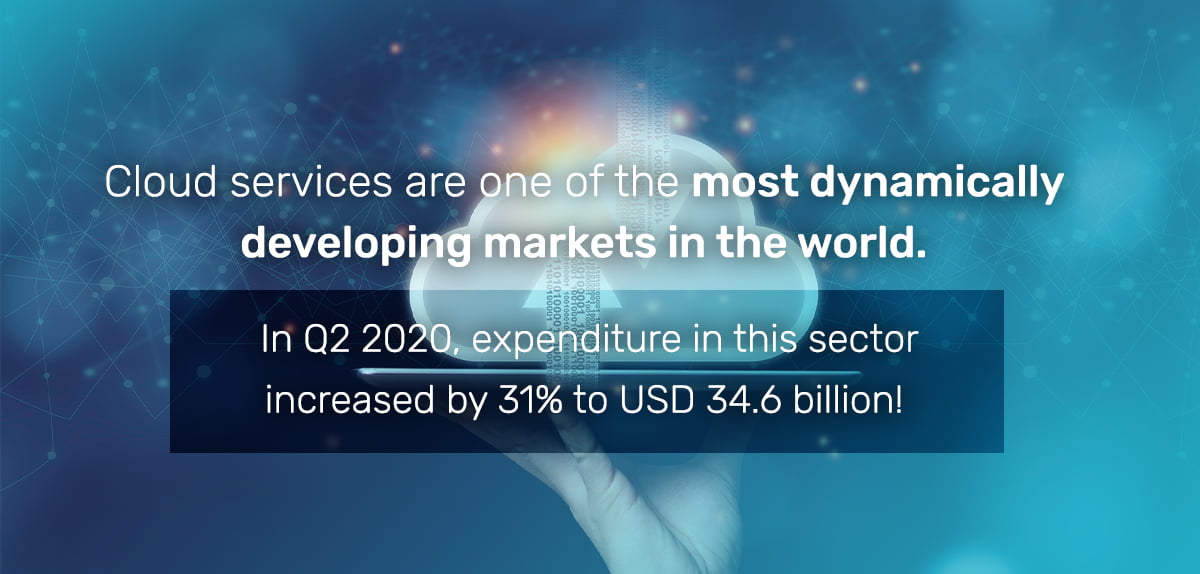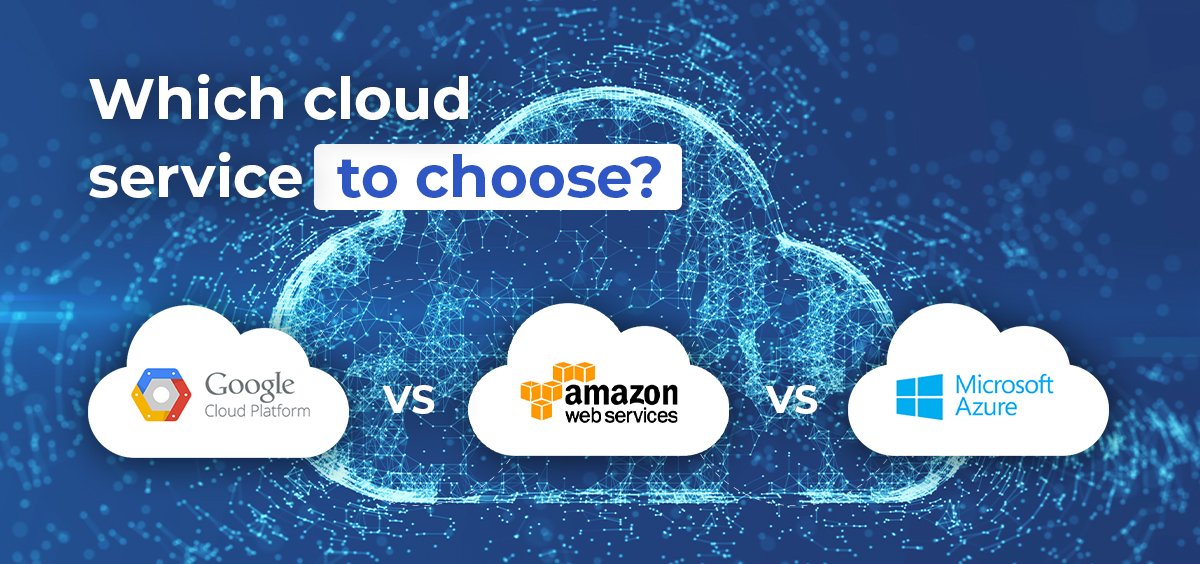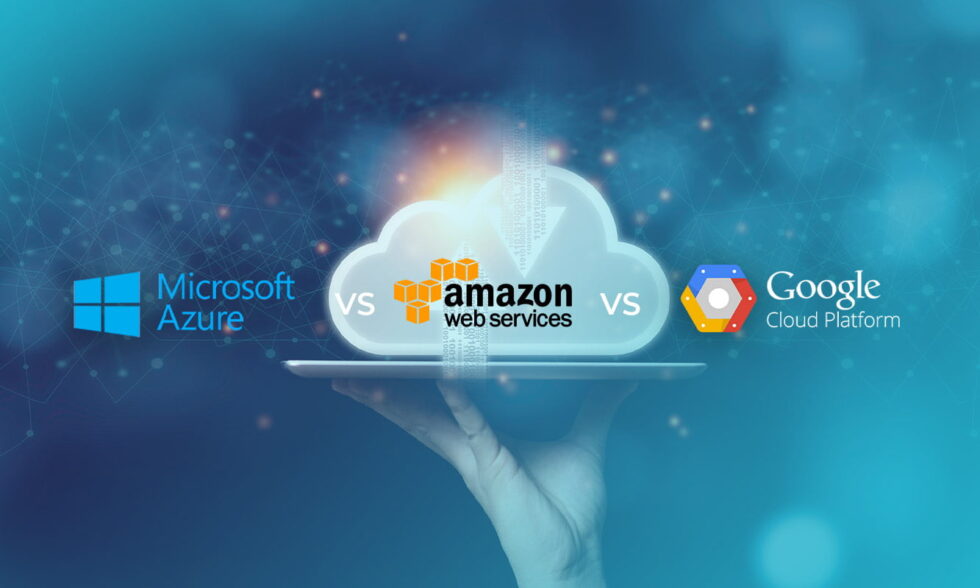Cloud services are one of the most dynamically developing markets in the world. In Q2 2020, expenditure in this sector increased by 31% to USD 34.6 billion. Companies are investing more and more in this sector, and this trend is not affected even by global crises such as the COVID-19 pandemic. Find out what makes clouds so popular in business and which cloud service to choose from the most popular: AWS, Azure or Google Cloud.
Even the most cautious reports on cloud computing infrastructure confirm the steady growth in investment in these technologies. Gartner published cloud market data for 2019, Canalys and Synergy Research summarized the first two quarters of 2020. Despite slight differences, they come to the same conclusion. Clouds are growing dynamically, have a huge number of users and there is no sign that their growth rate will slow down.
Thanks to the cloud, you do not incur costs related to infrastructure maintenance or ensuring security. The cloud provider takes care of that, and you usually only pay for the resources you use. The advantages of these solutions also include the high availability of applications and the ability to work remotely from anywhere with Internet access.
What is cloud computing?
Cloud computing is a service of sharing IT resources (computing power, databases, storage, etc.) via the Internet. Instead of buying all the necessary infrastructure on your own and incurring the costs of its maintenance, you only pay for the resources used, which are provided by an external provider such as AWS, Azure or Google Cloud.
There are three basic types of clouds:
- Public clouds
- Private clouds
- Hybrid clouds
There is also a fourth cloud type worth mentioning:
- Multicloud
 Public clouds
Public clouds
Services and applications are shared with the users via the Internet. They can be free or billed for actual use of the selected functionalities or applications. It is a very convenient alternative to the traditional approach, where you bought and maintained the equipment and application infrastructure on your own. The implementation of public cloud solutions saves a lot of time and money, and every employee can access data and applications remotely. Now the public clouds provide an almost unlimited ability to scale quickly, and many of them are kept at a security level comparable to private servers.
Private clouds
Private cloud, also known as internal or corporate, provides services via the Internet or a private network not to all, but only to selected clients. As in the case of the public cloud, providers provide the ability to increase individual data or functionalities as needed. Managing a private computing cloud is relatively easy and allows you to maintain comfortable operational flexibility. This type of “cloud computing” is distinguished by much higher security and privacy, mainly provided by customer’s internal servers and efficient firewalls. The main downside, however, is the need for the company to independently cover the expenses of private cloud management.
Hybrid clouds
Hybrid clouds combine the best of a private and a public cloud. Core processes and applications that do not use sensitive information are usually kept on the public cloud. However, confidential data and sensitive information can be kept on the company’s internal servers, providing them with much greater security. At the same time, you benefit from much more flexible scaling of the computing infrastructure, typical of the public cloud. You only pay for the resources you use, which is much more convenient than managing your own infrastructure on your own.
Multicloud
In addition to the basic types of computing clouds, there is a growing demand on the market for a solution that will integrate many different types of clouds. Such solution is Multicloud, i.e. application architecture that allows you to integrate two or more clouds and create applications using the necessary resources from various sources.
Multicloud integrates only services available in the cloud model, not hardware as in the case of a hybrid cloud. The cloud market is growing fast. Due to changes and new functionalities, it will take some time for Multicloud to reach the level of functionality that will allow the full potential of this solution to be realized.
These types of cloud computing are offered by many different vendors today. The market definitely belongs to three cloud service providers: Amazon, Microsoft and Google. Why do customers choose them, what are the differences between them and which cloud computing to choose for your business?
AWS, Azure and Google Cloud – comparison of billing models
Increasing competition and the dynamic development of clouds have made the prices of cloud services on the market very comparable. Since AWS, Azure and Google Cloud have very similar rates for the computing power consumed, it is worth taking a closer look at the billing models and discounts offered.
Amazon Web Services cloud
The undisputed leader of the cloud market. In the second quarter of 2020, Amazon Web Services owned 31% of the market (according to Canalys). AWS offers over 160 billing services:
- On demand – you pay for the resources used in the “pay-as-you-go” model, according to the operating time (in hours or seconds). This billing model is ideal for situations where you are not sure how much computing resources you need in your project.
- Instances reserved for IaaS – this is another model that allows companies to save on cloud use. The discount is automatically deducted from the invoice. There are three instance variants here: No Upfront Reserved (you do not pay in advance, but a fixed monthly fee with the discount included); Partial Upfront Reserved (you pay part of the fee in advance and the rest every month); All Upfront Reserved (you pay in advance for a specific period). Instances in AWS allow you to make certain changes (e.g. the type of networking). You can also use Convertible, thanks to which the discount is smaller, but you get much more possibilities to modify (e.g. you can change the type of operating system).
- Scheduled Reserved Instances – scheduled reservations. It saves 5 to 10% of expenses, but you get access to resources according to the planned schedule. It is ideal if the demand for cloud resources occurs at a specific time (e.g. in the case of an animation studio that renders 3D designs every evening or on selected days of the week).
Amazon Web Services cloud offers new customers the opportunity to try their services for free for 12 months. You can also use 22 services that are always free (but with limits).
There are also Savings Plans for the user, i.e. a flexible payment model, thanks to which it is possible to save up to 72% of expenses on IaaS, while also receiving the possibility of many modifications.
AWS offers a cost-effective option to buy an Amazon EC2 Spot instance. These are unused EC2 instances that operate as in the “On demand” model, except that AWS can disrupt and terminate their operation with 2 minutes’ notice. They can be combined with instances in other models and are rather an additional power supply for computing power. They allow you to save up to 90% compared to the “On demand” model.
An interesting solution in this model is the hibernation option, which allows you to stop and resume an instance in the exact same break point.
If you want to accurately estimate how much it will cost, use the AWS calculator: https://calculator.aws/#/?nc2=h_ql_pr_calc
Microsoft Azure cloud services
The Canalys report confirms that Microsoft Azure owns 20% of the cloud market. Microsoft offers over 200 products that you can pay for in the model of your choice:
- Pay-as-you-go – you pay according to the actual use of resources. After linking the card, the system charges the amount in accordance with the variable price list available on the supplier’s website. This is the most expensive billing model.
- Cloud Solution Provider – Azure provides the option of purchasing its services from its partners. You use the services and pay for them monthly based on the invoice issued. You have the option to set a limit for billed fees.
- Enterprise Agreement – intended for companies that want to license software and cloud services for a minimum of 3 years.
- Azure Reserved Instances – a billing model that allows you to save up to 72% compared to the “pay-as-you-go” model. If you have estimated what the minimum resources are needed to implement the project, you can use Azure reservations for one or three years.
- Spot – in this model you use unused computing power. Microsoft offers it even 90% cheaper than in the first presented model.
The price of Azure Cloud can be significantly reduced by using the following models: Azure Hybrid Benefit (when licensed with Software Assurance); Azure Extended Support for Windows and SQL Server (with Windows Server 2008 or SQL Server 2008 R2); Dev / Test pricing (you do not pay for Microsoft software and you have favorable discounts for applications in Azure services).
Microsoft Azure allows you to start using its services free of charge for one year, and you also get $ 200 to spend. In addition, as many as 25 services are available for free all the time (free, but with limits).
Azure Cloud allows you to estimate the cost of using your services with an online calculator: https://azure.microsoft.com/pl-pl/pricing/calculator/
Google Cloud services
In mid-2020, 6% of the market belonged to Google Cloud, making Google the third most popular cloud service provider. This provider offers over 100 cloud products. Google has approached the subject of billing differently from the competition, offering instances that you can exactly match to your requirements. GCP offers the following billing models:
- “Pay-as-you-go” (On demand price) – you pay for the seconds used. Google treats the amount of vCPU and RAM separately and bills them separately.
- Preemptible VM Instances – The most cost-effective instances, but operation is not guaranteed. The fee is not auction-based as with other providers but has a predetermined monthly price.
Google cloud computing also offers the possibility of reducing costs through several additional solutions.
Sustained use discounts – this is an automatic discount for the consistent use of cloud resources. The longer the instance runs, the more discount you get. VCPU and RAM rebates are billed separately, and you can save up to 30% (compared to the pay-as-you-go model).
Committed-use discounts – a price discount when booking for 1 or 3 years. This allows you to save up to 57% on most resources such as machine types or GPUs and up to 70% on memory optimized machine types.
As part of its cloud services, Google offers for a start $ 300 during a 3-month trial period and 23 free services (as with other providers, with certain limits).
If you want to know exactly what the price of using Google Cloud services will be, use the online calculator: https://cloud.google.com/products/calculator
AWS, Azure and Google Cloud – comparison of services
As mentioned above, the prices of the “Big Three” services are comparable and depend mainly on the type of billing model, the amount of resources used and the time of use. How do the cloud services compare?
All computing clouds provide their users with relational databases (such as Amazon Relational Database Service, Google Cloud SQL or Azure SQL Database). Each of them also offers beneficial data storage solutions.
Hybrid clouds are becoming more and more popular. Customers care about the integration of local infrastructure with the cloud, which is why each AWS, Azure and Google Cloud cloud services also offer solutions in this area: AWS – Outpost, Azure – Azure Stack, Google – Anthos.
There are quite a few similarities, so if you want to know which cloud service to choose, find out what makes each of them different in terms of the services.
Amazon Web Services
Amazon has been providing cloud services the longest. They are associated with well-developed, proven and secure public cloud services. The range of products offered is really wide, and the number of services is constantly growing with new innovative solutions. The AWS internship allowed the supplier to develop comprehensive solutions that work well in startups as well as in huge organizations with much higher requirements.
The number of available solutions can also be a disadvantage, as it is associated with a complex billing system.
AWS’s core offering includes EC2 services that can be easily combined with the provider’s other services. In the Amazon cloud we have many related services (EC2 Container, AWS Lambda or Elastic Beanstalk – PaaS solution). The undeniable advantages of this cloud include easy configuration of solutions, effective tools for monitoring and optimization of resources, and an effective data security policy.
Microsoft Azure Services
Microsoft offers many solutions commonly used by companies around the world. Azure uses these solutions, creating an environment conducive to business development. In addition to business management applications and solutions for developers, Microsoft Azure cloud places great emphasis on the development of AI and open source solutions.
The leading segments of services in Azure are virtual machines and practical tools (Azure Autoscaling, Cloud Services or Resource Manager).
The advantage of Microsoft Azure cloud service is the compatibility of the cloud with products used by most companies in the world on a daily basis. Microsoft tries hard to make it as easy as possible for users to use all their solutions.
Google Cloud
Google Cloud is the youngest cloud service in the “Big Three”. It has an extensive network of proprietary products for both individuals and companies, including operating systems and office toolkits commonly used in business. It is appreciated for its modern approach and innovation, as well as extensive technical facilities.
The biggest advantage of Google cloud services is the highly developed machine learning and analytics as well as the development of artificial intelligence. Major cloud products include Compute Engine (virtual machines running in supplier data centers) and Kubernetes (open source environment for managing and scaling container applications).
Other clouds available on the market
AWS, Azure and Google Cloud are not the only cloud service providers. It is also worth mentioning Oracle Cloud, IBM Cloud, and above all – breathing down Google’s neck – Alibaba Cloud (5% market share in Q2 2020 according to Canalys). Many more similar companies may emerge soon, with new solutions and proposals for companies.
You can be sure that the cloud market will grow even faster than before. According to IDC, the cloud services market is expected to reach USD 370 billion in 2022. As a result, prices, quality and the number of services will be changing very dynamically. Keep that in mind when it comes to selecting the cloud service. So how do you find a cloud solution that works best for your business?
 Which cloud service to choose?
Which cloud service to choose?
To sum up, the three most frequently chosen clouds in 2020 were AWS, Azure and Google Cloud. There are many factors that influence the choice of a cloud service. In addition to comparing the cloud solutions themselves, you should determine what specific cloud services you need (e.g. what computing power and for how long will be necessary to perform the activities). This way you will choose the cloud that is best for you, not only in terms of functionality, but also financially.
Each of the platforms presented above appreciates business-conscious customers. If you estimate the potential demand for resources in advance, you will be rewarded with very favorable price discounts. If you want a specific answer, which cloud is the cheapest, use the calculators provided by each provider.
AWS clouds, Microsoft Azure and Google Cloud Platform, despite some differences, offer similar solutions, services and products. Each supplier improves the processes related to the storage and management of data and improves their flow and integration. More and more emphasis is also placed on digital security, intuitive systems, AI, integration with external servers, as well as the possibility of efficient and automatic scaling of projects.
Choosing a cloud service can help develop your business or slow it down, so pay special attention to choosing the best provider for you. If you need expert’s opinion, please contact us. We will help you examine the needs of your company, answer any questions and advise you which solution will be best for your company. Check also in which areas of cloud services we can help you!
References:
Global cloud services market Q2 2020, Canalys
Quarterly Cloud Spending Blows Past $30B; Incremental Growth Continues to Rise, Synergy Research
Forecast: Public Cloud Services, Worldwide, 2017-2023, 3Q19 Update, Gartner




